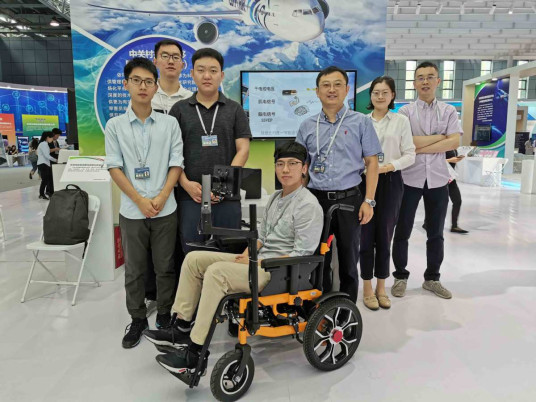Brainpower helps ease the route for wheelchair users
 |
|
Zheng Dezhi, third right, and his team display their robotic wheelchair during this year's Week for Innovation and Startups in Beijing. CHINA DAILY |
Imagine looking at a computer screen displaying several numbers in different boxes and being asked to stare randomly at one number.
Two or three seconds later, the box you are looking at turns green, and in another second, the number in the box is entered automatically into the computer.
The ability to decode thought in this way may sound like the stuff of science fiction. But as brain-computer interface technology has developed, individuals can input data using only brain signals, without any muscle movements.
At the School of Instrumentation and Optoelectronic Engineering at Beihang University in Beijing, Zheng Dezhi, 41, and his team are using this technology to help those with disabilities command their wheelchairs and make their daily lives easier.
Zheng said that by measuring and analyzing brain signals, brain-computer interface technology can transform them into commands for specific equipment.
This is based on "steady state visually evoked potential" - a resonance phenomenon aroused in the visual cortex that can be easily triggered when a person looks attentively at a light source flickering at a specific frequency.
Unlike some sensors, which need to be implanted in the brain and carry a risk of bodily rejection, the method Zheng and his team of nine students chose to register the electrical activity along the scalp uses electrodes placed directly on the scalp's surface. The team chose to place the electrodes over the occipital region of the brain, as this produces the strongest signals.
In the team's 140-square-meter laboratory, many electrodes are used to detect electrical activity.
"We have developed our own wearable electrodes. Users must place them on a specific area and have a screen attached to a robotic wheelchair. A stimuli system, consisting of eight square boxes, which represent different movement commands, appears on the screen," Zheng said.
The frequency of flickering in each box is different. By detecting and matching the frequency in a specific box that is being watched by the user, the robotic wheelchair decodes the signal that is sent. This allows a command to be selected to enable the wheelchair to be driven to a target by following a predetermined path.
"The first time I used this wheelchair, it felt as if I was in a science fiction movie," said Zhang Feiyang, 22, who became one of the first to experience the robotic conveyance.
"It is so obedient, and as long as I focus on the box on the screen, the wheelchair will go in the direction I want, which feels really good," he added.
Zheng said: "This detection of a faint signal is an applied science, in which Beihang University has a proud history. But we used to apply our sensors to machine production, rather than individual activities."
He said it was not until 2011, when he implemented a project with the Chinese Academy of Science to use a sensor to detect vibration in a frog's eardrum, that he began to consider biological detection.
Zheng and his team next carried out several biological projects, such as measuring the amount of C-reactive proteins, which are generated when a person is infected or injured. From 2017, the team began to focus on steady state visually evoked potential, and last year started thinking about inventing a robotic wheelchair for people with disabilities.
"We intend to help those who have lost their arms, as well as people with amyotrophic lateral sclerosis and paraplegia," Zheng said. Amyotrophic lateral sclerosis, also known as motor neurone disease or Lou Gehrig's disease, causes the death of neurons that control muscles.
On the scalp, the electrical activity signal is very faint. While the signal for the heart's electrical activity is measured in millivolts, that for the scalp is gauged in microvolts, which are thousands of times smaller than the former. This means that detection of brain activity requires a more precise sensor as well as a higher threshold to eliminate disturbance.
The typical solution to reduce disturbance is to use electrode jelly to stick the electrodes to the scalp. But this is time-consuming, because the hair has to be washed beforehand, and there is a wait for the jelly to dry. Zheng said it usually takes 45 minutes to fix the electrodes in this manner.
"This traditional method is too complex to become widely used. Fixing the electrodes more quickly and conveniently has posed a challenge for us," he said.
"We tried two methods. The first was to use a holder which could not be adjusted to fit different head shapes. The second was designed as a swimming cap, which solved the previous problem but was hard to wear."
In May, Zheng and his team developed a hairband-style device, which can be fitted in just 15 seconds and is more comfortable.
But now the team has another problem. Although the signal in the occipital region of the brain is the strongest, disturbing the hair means the electrodes experience a higher level of interference. The team is trying to improve the sensor to detect signals on the ears and forehead, where there is less or no interference.
Zheng is optimistic about brain-computer interface technology based on steady state visually evoked potential and thinks this could be applied to computer keyboards to better protect passwords, or be used to control intelligent home systems.
"Helping people in wheelchairs is only one important aspect, as there are more and bigger areas that need our exploration," he said.

